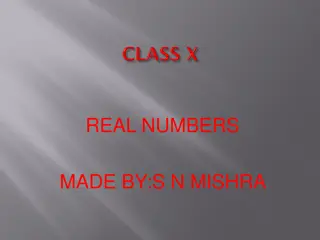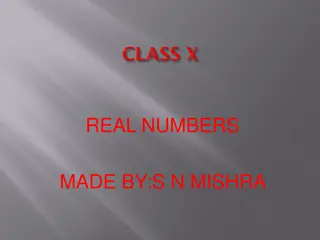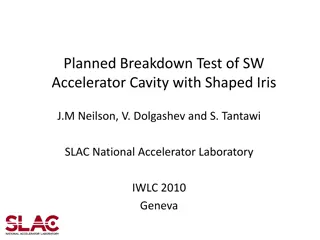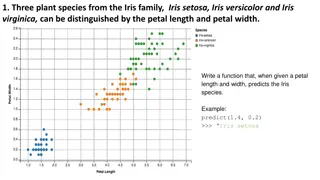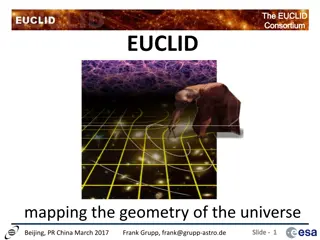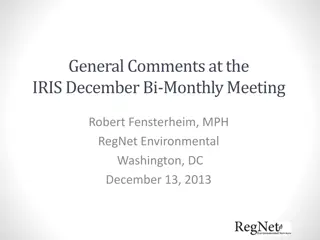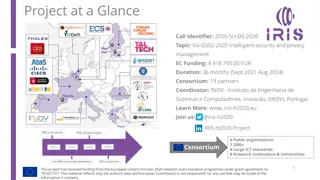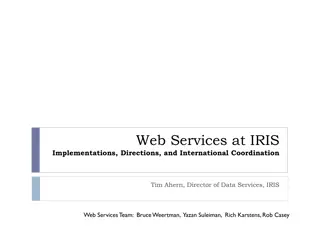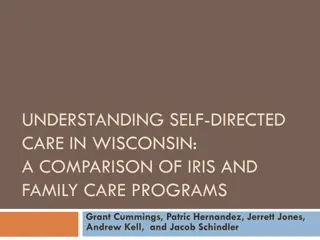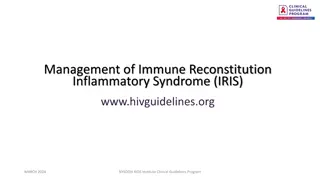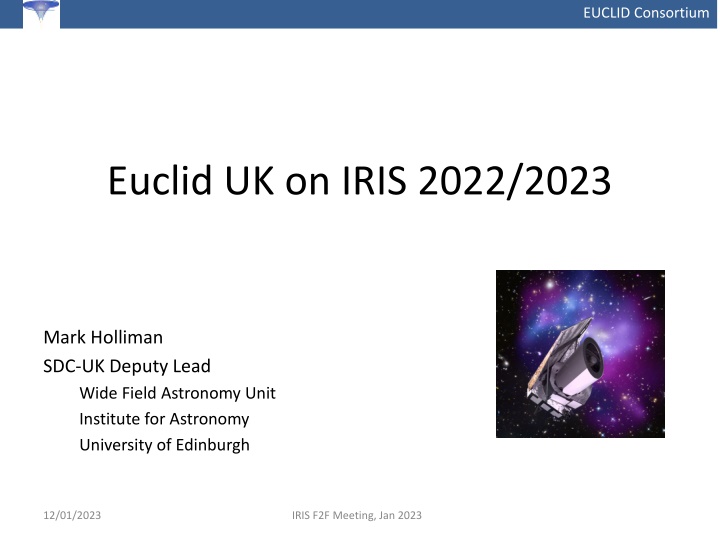
Euclid Consortium: Exploring Cosmic Mysteries and Dark Energy through Astronomy
Join the EUCLID Consortium on their mission to explore the origins of the Universe's accelerated expansion. With a focus on understanding Dark Energy and cosmic structure formation, the consortium involves scientists from 15 countries and aims to launch in July 2023. Learn more about their work on galaxy modeling, weak gravitational lensing, and data processing for this groundbreaking project.
Download Presentation

Please find below an Image/Link to download the presentation.
The content on the website is provided AS IS for your information and personal use only. It may not be sold, licensed, or shared on other websites without obtaining consent from the author. If you encounter any issues during the download, it is possible that the publisher has removed the file from their server.
You are allowed to download the files provided on this website for personal or commercial use, subject to the condition that they are used lawfully. All files are the property of their respective owners.
The content on the website is provided AS IS for your information and personal use only. It may not be sold, licensed, or shared on other websites without obtaining consent from the author.
E N D
Presentation Transcript
EUCLID Consortium Euclid UK on IRIS 2022/2023 Mark Holliman SDC-UK Deputy Lead Wide Field Astronomy Unit Institute for Astronomy University of Edinburgh 12/01/2023 IRIS F2F Meeting, Jan 2023
EUCLID Consortium Euclid Summary ESA Medium-Class Mission In the Cosmic Visions Programme M2 slot (M1 Solar Orbiter, M3 PLATO) Due for launch on a SpaceX Falcon 9 in July 2023! Largest astronomical consortium in history: 15 countries, ~2000 scientists, ~200 institutes. Mission data processing and hosting will be spread across 9 Science Data Centres in Europe and US (each with different levels of commitment). Scientific Objectives To understand the origins of the Universe s accelerated expansion Using at least 2 independent complementary probes (5 probes total) Geometry of the universe: Weak Lensing (WL) Galaxy Clustering (GC) Cosmic history of structure formation: WL, Redshift Space Distortion (RSD), Clusters of Galaxies (CL) 12/01/2023 IRIS F2F Meeting, Jan 2023
EUCLID Consortium Euclid UK on IRIS in 2022 Three main areas of work: OU-SHE Code Development and testing: Algorithm and software pipeline development of Shear Lensing codes for processing mission data Mission Data Processing scale out: Proof of concept using IRIS Slurm as a Service (Saas) infrastructure to scale out workloads from the dedicated cluster in Edinburgh to resources at other IRIS providers. Science Working Group Simulations (led by Tom Kitching): Science Performance Verification (SPV) simulations for setting the science requirements of the mission and used to assess the impact of uncertainty in the system caused by any particular pipeline function or instrument calibration algorithm. 2022 Cloud Allocations (all on OpenStack) RAL SCD: ~2000 vCPUs, Cambridge Cloud: ~1134 CPUs, Imperial: ~1500 CPUs Saas (Slurm As A Service) cluster running at Cambridge, RAL, Imperial OpenStack Clouds, with head node in Edinburgh OpenVPN Mesh connecting all sites/nodes to the head node Shared filesystems are only visible at each site and head node, each site is a separate Slurm partition Cambridge partition has CephFS provided onsite. RAL partition has shared filesystem built using OpenStack provided ephemeral storage through a federated Ceph system. Imperial allocation has shared filesystem built using OpenStack provided ephemeral storage through a federated Ceph system. 12/01/2023 IRIS F2F Meeting, Jan 2023
EUCLID Consortium OU-SHE Code Development 2022 Description of work: The success of Euclid to measure Dark Energy to the required accuracy relies on the ability to extract a tiny Weak Gravitational Lensing signal (a 1% distortion of galaxy shapes) to high-precision (an error on the measured distortion of 0.001%) and high accuracy (residual biases in the measured distortion below 0.001%), per galaxy (on average), from a large data-set (1.5 billion galaxy images). Both errors and biases are picked up at every step of the analysis. We are tasked with testing the galaxy model-fitting algorithm the UK has developed to extract this signal and to demonstrate it will work on the Euclid data, ahead of ESA Review and code-freezing for Launch. 12/01/2023 IRIS F2F Meeting, Jan 2023
EUCLID Consortium OU-SHE Code Development 2022 Main Development Activities LensMC algorithm testing: Large scale tests of shape measurement on simulated galaxies SHE pipeline sensitivity testing: Large scale tests of SHE pipeline on simulated images PSF calibration testing: Calibration routine tests using GPUs (nVidia A100 40GB) Use of IRIS Resources Saas cluster (~4,500 cores) across RAL, Cambridge, and Imperial RAL and Cambridge partitions largely used for SHE pipeline sensitiy testing, large scale generation and analysis of simulated galaxy images ~90% of Imperial allocation was switched over to GridPP in September to allow for opportunistic use of Grid resources by LensMC tests. LensMC developers started runs mid-summer, and at times utilized >~10k cores for a testing campaign. We subsequently created the EuclidUK.net VO, and are officially on the grid now. This will likely remain in place for 2023. GPU at Cambridge PSF routines were tested on the Cambridge cluster GPU nodes 12/01/2023 IRIS F2F Meeting, Jan 2023
EUCLID Consortium Mission Data Processing Description of work: Euclid Mission Data Processing will be performed at 9 Science Data Centres (SDCs) across Europe and the US. Each SDC will process a subsection of the sky using the full Euclid pipeline, and resulting data will be hosted at archive nodes at each SDC throughout the mission. The expected processing workflow will follow these steps: 1. Telescope data is transferred from satellite to ESAC. Level 1 processing occurs locally (removal of instrumentation effects, insertion of metadata). 2. Level 1 data is copied to target SDCs (targets are determined by national Mission Level Agreements, and distribution is handled automatically by the archive). Associated external data (DES, LSST, etc) is distributed to the target SDCs (this could occur prior to arrival of Level 1 data). 3. Level 2 data is generated at each SDC by running the full Euclid pipeline end-to-end on the local data (both mission and external). Results are stored in a local archive node, and registered with the central archive. 4. Necessary data products are moved to Level 3 SDCs for processing of Level 3 data (LE3 data is expected to require specialized infrastructure in many cases, such as GPUs or large shared memory machines). 5. Data Release products are declared by the Science Ground Segment Operators and then copied back to the Science Operations Centre (SOC) at ESAC for official release to the community. 6. Older release data, and or intermediate data products, are moved from disk to tape on a regular schedule. The data movement is handled by the archive nodes, using local storage services. 12/01/2023 IRIS F2F Meeting, Jan 2023
EUCLID Consortium SDC-UK Architecture 12/01/2023 IRIS F2F Meeting, Jan 2023
EUCLID Consortium Mission Data Processing con t Working Environment Nodes/containers running Rocky 9 CVMFS access to euclid.in2p3.fr and euclid-dev.in2p3.fr repositories 6GB RAM per core, cores can be virtual Shared filesystem visible to the head node and workers. Preferably with high sequential IO rates (Ceph, Lustre, etc) Euclid job submission service (called the IAL) needs to be running on/near the head node for overall workflow management, and communicates with Torque/SGE/Slurm DRM PSF Calibration Tests Point Spread Function (PSF) calibration routines utilize GPUs. Use of IRIS Resources in 2022 Mission data processing tests were run successfully in 2022 using ~6/8 of the main pipeline processing functions. The remaining 2 processing functions encountered performance issues on the shared filesystems (causing disruption to other users at Cambridge, and grinding to a halt on our federated Ceph at RAL). 12/01/2023 IRIS F2F Meeting, Jan 2023
EUCLID Consortium Science Working Group 2022 Description of work: The Science Working Groups (SWG) set the science requirements for the algorithm developers and also the instrument teams, and assess the expected scientific performance of the mission. The UK leads the weak lensing SWG (WLSWG; Kitching), which is tasked with Science Performance Verification (SPV) for testing the Euclid weak lensing pipeline. Use of IRIS Resources 500 Cores on Saas Federated CephFS (ephemeral storage) performance was adequate for most routines tested, but not all. 12/01/2023 IRIS F2F Meeting, Jan 2023
EUCLID Consortium Euclid on IRIS 2023 Mission Data Processing Resource level increasing from 2022, up to 500 core years (and possibly more depending on post-launch workloads). From 2024 onwards we expect usage to grow into 2-3k cores per year. Shared FS performance constraints still an issue for some pipeline processing functions. GPU time requested as a backup service for PSF calibrations used in mission operations (failover for our dedicated GPU cluster at ROE). OU-SHE Code Development Resource levels will reduce in 2023 due to limited developer effort. 2022 was ~4500 cores, 2023 will reduce to ~2900 cores ~1200 cores on Saas cluster, ~1,700 cores on GridPP Usage in 2024 will likely rebound to higher levels due to more developer effort and the realities of analyzing mission data. SWG Code Development Resource levels will increase in 2023, especially post-launch. More interesting use cases, resource needs, and resource levels are anticipated in 2024 onwards (once mission data is available). Saas updates Rebuild entire Saas cluster on Rocky 9 Migrate to site hosted CephFS (OpenStack Manila) at RAL SCD 12/01/2023 IRIS F2F Meeting, Jan 2023

